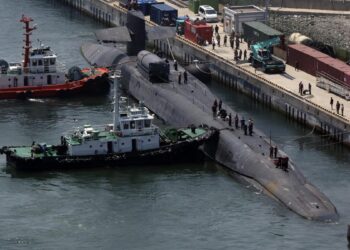[ad_1]
A year after the Ukraine war began, there are growing speculations about the ability of Russia, hit by heavy western sanctions and faced with dwindling exports, to continue tosupply defence systems to India, one of its most important defence customers. Such concerns are largely rooted in payment problems that India and Russia are yet to resolve, according to sources in the Russian government, defence, and banking sectors. However, experts believe the setbacks that Russian defence exports face due to sanctions could be outweighed by advantages Moscow may have once the war is over.
There were media reports last month that India may not get the delivery of the two remaining S-400 Triumf missile defence systems that it had ordered in 2018 for around $5.4 billion. The reports cited the 34th Report of the Standing Committee on Defence (2022-23), presented in the Lok Sabha on March 21, where a representative of the Air Force suggested that the sharp decline in the budget estimate for the fiscal year was related to “some of our deliveries not taking place”.
Also read | Russian arms supplies to India worth $13 billion in past 5 year: Reports
Russian officials refuted the media reports. “Russian-Indian defence cooperation is developing steadily in accordance with previously reached agreements and signed documents,” said the Federal Service for Military-Technical Cooperation (FSVTS), which oversees military-technical cooperation with foreign countries.
When The Hindu approached, the FSVTS, state-owned defence manufacturer Rostec, its agency for exports and imports of defence-related items Rosoboronexport and Concern VKO Almaz-Antey, the maker of S-400 systems, all refused to provide any additional comments and referred to the March statement. The Russian embassy in New Delhi, too, said there is nothing more to add at this point.
Money first
Off the record, however, officials admit payment remains an issue when it comes to trade with India.
File photo of the Russian S-400 missile air defence systems.
| Photo Credit:
Reuters
Russia is currently fulfilling several major contracts previously signed with India, including, the S-400 systems and two Project 11356 frigates. There are more deals on the plate, including procurement of additional and modernisation of existing Sukhoi Su-30 MKI and upgrade of MIG-29s, where no final terms have been achieved. Several commenters suggested that such contracts will not be signed till the Ukraine conflict is over.
A source in the Russian defence industry said payments remain the key issue for the aircraft deals being negotiated. He noted that while India “doesn’t have many options” when it comes to fighter jets and helicopters, given both the budgets available and urgency in bringing Air Force strength to sanctioned 42 squadrons, the country’s push for increasing indigenous manufacturing is something Russian original equipment manufacturers (OEMs) account for.
Also read | Customised defence deals offered to offset sanctions impact, says senior Russian military official
India’s total imports from Russia rose by five times from $8.5 billion in April 2022 to $41.6 billion in February 2023, driven mainly by oil supplies. A source in the banking industry with direct knowledge of negotiations on payments said almost the entire amount of this $41 billion has now accumulated in the vostro accounts opened by Russian banks with authorised dealer banks in India.
Russian authorities have not yet decided on how to use this money, the person added. There are several options and mechanisms being worked out, including investments within India as well as converting into third countries’ currency. But the most preferable way for Russia to get further payments would be roubles — something that India is not able to do, unlike some other countries. The person did not specify which countries pay Russia directly in roubles.
Aleksei Zakharov, research fellow at the School of International Affairs, Higher School of Economics, pointed out two key impediments in rouble payment: first, the concerns of the Indian financial sector which is overall slowly adopting new mechanisms, and second, lack of trust on the Russian rouble.
“India is hesitant about the rouble after it experienced a serious shock last year, and there is an understanding that it is almost impossible to evaluate it correctly. Therefore, the Indian side has no particular interest in trading in the Russian currency and Delhi tried to rely on payments in the rupees. But then, the question Russia faces is whether it needs such an overabundance in the rupees. There is a discussion about what to do with this overabundance and how to adapt to this currency; it turns out that it is not possible to take the profit out, instead it can only be reinvested”.
Agreed Alexey Kupriyanov, Senior Research Fellow at the Institute of World Economy and International Relations (IMEMO), Moscow. “Indian banks that are afraid to take risks and process the payments are simply losing money. If these excessive fears are overcome, it will greatly help to streamline the cooperation between countries.”
“If there was something that Russia could buy from India for $40 billion, there would be no problems — in that case, the existing rupee-rouble mechanism would be enough. But there is nothing that Russia can import at such a scale,” the banking source quoted above said.
This issue is likely to be discussed on April 17-18, when a delegation from Russia travels to New Delhi for a meeting of the India-Russia Intergovernmental Commission on Trade, Economic, Scientific, Technological and Cultural Cooperation (IRIGC-TEC). The Commission will meet in person for the first time after a five-year break — the last session, the 23rd (the first meeting took place in 1994) was held in 2018 in Moscow.
“The two sides agreed to work together to unlock the full potential of India-Russia bilateral trade and economic relations, including through addressing the trade deficit and market access issues,” India’s Ministry of External Affairs stated back in March after Minister S. Jaishankar held a virtual meeting with Denis Manturov, Russia’s Deputy PM and Minister of Trade and Industry.
Trade diversification was the focus of the business forum organised by the Russian side in New Delhi on March 29-30. However, defence is the mainstay of the trade between the countries and Russia’s defence industry is facing renewed challenges in recent years.
Declining share
Russian defence exports dropped by 46% in 2022 from the year before. “It is clear that a significant part of the weapons are produced for domestic consumption, for the needs of the armed forces, but even in these conditions, we have already sold $8 billion worth of weapons in the world markets,” Russian President Vladimir Putin said late last year. According to Dmity Shugaev, the head of the FSVTS, Russia exported weapons worth $14.6 billion in 2021. Russia exports weapons to Syria, Iraq, Egypt, India, China, Algeria and Kazakhstan.
According to the latest report by the Stockholm International Peace Research Institute (SIPRI), a Swedish think tank, Russian arms exports remained stable between 2008-12 and 2013–17, but fell by 31% between 2013–17 and 2018–22. The annual volumes of arms exports started reducing significantly after 2019, SPIRI noted.
This is both due to Western sanctions, particularly the U.S. defence sanctions expanded in 2017 through the Countering America’s Adversaries Through Sanctions Act (CAATSA), aimed at restricting Russia’s ability to raise export revenues, as well as increasing pressure on Russian trade partners, experts note. As a result, Russia’s share of global arms exports fell from 22% in 2013-2017 to 16% in 2018-22, while that of the U.S. increased from 33% to 40% in the same period.
SIPRI data show Russia’s share of arms imports to India fell from 69% in 2012-17 to 46% in 2017-21, while Moscow still remained the key defence supplier to New Delhi. These figures, however, should be put in the context.
Grey zone
Apart from sanctions-related issues outlined above, experts point out that a large chunk of Russia’s defence exports are in a “grey zone” with no data available — and access to any trade data was restricted further by the Russian government since the beginning of the Ukraine invasion. Another important factor is that India’s requirement has changed, and there are certain specific systems that Russia is not able to supply.
Moreover, all foreign players in the Indian defence market were impacted by its policy shift under India’s Atma Nirbhar Bharat and Make In India initiatives, according to Mr. Kupriyanov of the IMEMO.
Also read: Explained | Strains on India-Russia defence cooperation
“India is striving to increase weapons exports and domestic production. The situation where India imports defence items worth billions is no longer valid. Therefore, all the players are looking for new ways and new opportunities in the Indian market — through joint ventures, through setting up such enterprises where R&D would be distributed between partners, or by including Indian domestic manufacturers into OEM’s global production chains,” he said.
Post-war possibilities
While he admitted the situation is not very favourable for Russia, sooner or later the conflict will end. “Russia is likely to emerge from the conflict having a range of weapons that are tested in combat and that are significantly improved and upgraded based on their real-time performance. This will give Russia a great advantage in terms of defence exports,” Mr. Kupriyanov added.
Rostec chief Sergey Chemezov, earlier this year, noted that some of the performing weapons during the Ukraine war, were T-90M tanks, Iskander missiles and various types of multiple launch rocket system (MLRS) as well as combat aircraft such as Ka-52 and Mi-28 helicopters, Su-35S and Su-57 fighters, Cube and Lancet drones. At Aero India in Bangalore, Rosoboronexport chief Alexander Mikheev said Russia has showcased its reconnaissance and strike drone Orlan and long-duration UAV Orion-E, which could be of interest to both military and civilian customers.
He noted that with the increased role of UAVs not just in the battlefield, but for securing critical infrastructure sites, the demand for both UAVs and radar complexes able to detect them could give a boost to Russia’s export portfolio.
But for the big business to take off, the conflict should come to an end first.
Ksenia Kondratieva is an independent journalist based in St. Petersburg, Russia.
[ad_2]
[ad_1]
A year after the Ukraine war began, there are growing speculations about the ability of Russia, hit by heavy western sanctions and faced with dwindling exports, to continue tosupply defence systems to India, one of its most important defence customers. Such concerns are largely rooted in payment problems that India and Russia are yet to resolve, according to sources in the Russian government, defence, and banking sectors. However, experts believe the setbacks that Russian defence exports face due to sanctions could be outweighed by advantages Moscow may have once the war is over.
There were media reports last month that India may not get the delivery of the two remaining S-400 Triumf missile defence systems that it had ordered in 2018 for around $5.4 billion. The reports cited the 34th Report of the Standing Committee on Defence (2022-23), presented in the Lok Sabha on March 21, where a representative of the Air Force suggested that the sharp decline in the budget estimate for the fiscal year was related to “some of our deliveries not taking place”.
Also read | Russian arms supplies to India worth $13 billion in past 5 year: Reports
Russian officials refuted the media reports. “Russian-Indian defence cooperation is developing steadily in accordance with previously reached agreements and signed documents,” said the Federal Service for Military-Technical Cooperation (FSVTS), which oversees military-technical cooperation with foreign countries.
When The Hindu approached, the FSVTS, state-owned defence manufacturer Rostec, its agency for exports and imports of defence-related items Rosoboronexport and Concern VKO Almaz-Antey, the maker of S-400 systems, all refused to provide any additional comments and referred to the March statement. The Russian embassy in New Delhi, too, said there is nothing more to add at this point.
Money first
Off the record, however, officials admit payment remains an issue when it comes to trade with India.
File photo of the Russian S-400 missile air defence systems.
| Photo Credit:
Reuters
Russia is currently fulfilling several major contracts previously signed with India, including, the S-400 systems and two Project 11356 frigates. There are more deals on the plate, including procurement of additional and modernisation of existing Sukhoi Su-30 MKI and upgrade of MIG-29s, where no final terms have been achieved. Several commenters suggested that such contracts will not be signed till the Ukraine conflict is over.
A source in the Russian defence industry said payments remain the key issue for the aircraft deals being negotiated. He noted that while India “doesn’t have many options” when it comes to fighter jets and helicopters, given both the budgets available and urgency in bringing Air Force strength to sanctioned 42 squadrons, the country’s push for increasing indigenous manufacturing is something Russian original equipment manufacturers (OEMs) account for.
Also read | Customised defence deals offered to offset sanctions impact, says senior Russian military official
India’s total imports from Russia rose by five times from $8.5 billion in April 2022 to $41.6 billion in February 2023, driven mainly by oil supplies. A source in the banking industry with direct knowledge of negotiations on payments said almost the entire amount of this $41 billion has now accumulated in the vostro accounts opened by Russian banks with authorised dealer banks in India.
Russian authorities have not yet decided on how to use this money, the person added. There are several options and mechanisms being worked out, including investments within India as well as converting into third countries’ currency. But the most preferable way for Russia to get further payments would be roubles — something that India is not able to do, unlike some other countries. The person did not specify which countries pay Russia directly in roubles.
Aleksei Zakharov, research fellow at the School of International Affairs, Higher School of Economics, pointed out two key impediments in rouble payment: first, the concerns of the Indian financial sector which is overall slowly adopting new mechanisms, and second, lack of trust on the Russian rouble.
“India is hesitant about the rouble after it experienced a serious shock last year, and there is an understanding that it is almost impossible to evaluate it correctly. Therefore, the Indian side has no particular interest in trading in the Russian currency and Delhi tried to rely on payments in the rupees. But then, the question Russia faces is whether it needs such an overabundance in the rupees. There is a discussion about what to do with this overabundance and how to adapt to this currency; it turns out that it is not possible to take the profit out, instead it can only be reinvested”.
Agreed Alexey Kupriyanov, Senior Research Fellow at the Institute of World Economy and International Relations (IMEMO), Moscow. “Indian banks that are afraid to take risks and process the payments are simply losing money. If these excessive fears are overcome, it will greatly help to streamline the cooperation between countries.”
“If there was something that Russia could buy from India for $40 billion, there would be no problems — in that case, the existing rupee-rouble mechanism would be enough. But there is nothing that Russia can import at such a scale,” the banking source quoted above said.
This issue is likely to be discussed on April 17-18, when a delegation from Russia travels to New Delhi for a meeting of the India-Russia Intergovernmental Commission on Trade, Economic, Scientific, Technological and Cultural Cooperation (IRIGC-TEC). The Commission will meet in person for the first time after a five-year break — the last session, the 23rd (the first meeting took place in 1994) was held in 2018 in Moscow.
“The two sides agreed to work together to unlock the full potential of India-Russia bilateral trade and economic relations, including through addressing the trade deficit and market access issues,” India’s Ministry of External Affairs stated back in March after Minister S. Jaishankar held a virtual meeting with Denis Manturov, Russia’s Deputy PM and Minister of Trade and Industry.
Trade diversification was the focus of the business forum organised by the Russian side in New Delhi on March 29-30. However, defence is the mainstay of the trade between the countries and Russia’s defence industry is facing renewed challenges in recent years.
Declining share
Russian defence exports dropped by 46% in 2022 from the year before. “It is clear that a significant part of the weapons are produced for domestic consumption, for the needs of the armed forces, but even in these conditions, we have already sold $8 billion worth of weapons in the world markets,” Russian President Vladimir Putin said late last year. According to Dmity Shugaev, the head of the FSVTS, Russia exported weapons worth $14.6 billion in 2021. Russia exports weapons to Syria, Iraq, Egypt, India, China, Algeria and Kazakhstan.
According to the latest report by the Stockholm International Peace Research Institute (SIPRI), a Swedish think tank, Russian arms exports remained stable between 2008-12 and 2013–17, but fell by 31% between 2013–17 and 2018–22. The annual volumes of arms exports started reducing significantly after 2019, SPIRI noted.
This is both due to Western sanctions, particularly the U.S. defence sanctions expanded in 2017 through the Countering America’s Adversaries Through Sanctions Act (CAATSA), aimed at restricting Russia’s ability to raise export revenues, as well as increasing pressure on Russian trade partners, experts note. As a result, Russia’s share of global arms exports fell from 22% in 2013-2017 to 16% in 2018-22, while that of the U.S. increased from 33% to 40% in the same period.
SIPRI data show Russia’s share of arms imports to India fell from 69% in 2012-17 to 46% in 2017-21, while Moscow still remained the key defence supplier to New Delhi. These figures, however, should be put in the context.
Grey zone
Apart from sanctions-related issues outlined above, experts point out that a large chunk of Russia’s defence exports are in a “grey zone” with no data available — and access to any trade data was restricted further by the Russian government since the beginning of the Ukraine invasion. Another important factor is that India’s requirement has changed, and there are certain specific systems that Russia is not able to supply.
Moreover, all foreign players in the Indian defence market were impacted by its policy shift under India’s Atma Nirbhar Bharat and Make In India initiatives, according to Mr. Kupriyanov of the IMEMO.
Also read: Explained | Strains on India-Russia defence cooperation
“India is striving to increase weapons exports and domestic production. The situation where India imports defence items worth billions is no longer valid. Therefore, all the players are looking for new ways and new opportunities in the Indian market — through joint ventures, through setting up such enterprises where R&D would be distributed between partners, or by including Indian domestic manufacturers into OEM’s global production chains,” he said.
Post-war possibilities
While he admitted the situation is not very favourable for Russia, sooner or later the conflict will end. “Russia is likely to emerge from the conflict having a range of weapons that are tested in combat and that are significantly improved and upgraded based on their real-time performance. This will give Russia a great advantage in terms of defence exports,” Mr. Kupriyanov added.
Rostec chief Sergey Chemezov, earlier this year, noted that some of the performing weapons during the Ukraine war, were T-90M tanks, Iskander missiles and various types of multiple launch rocket system (MLRS) as well as combat aircraft such as Ka-52 and Mi-28 helicopters, Su-35S and Su-57 fighters, Cube and Lancet drones. At Aero India in Bangalore, Rosoboronexport chief Alexander Mikheev said Russia has showcased its reconnaissance and strike drone Orlan and long-duration UAV Orion-E, which could be of interest to both military and civilian customers.
He noted that with the increased role of UAVs not just in the battlefield, but for securing critical infrastructure sites, the demand for both UAVs and radar complexes able to detect them could give a boost to Russia’s export portfolio.
But for the big business to take off, the conflict should come to an end first.
Ksenia Kondratieva is an independent journalist based in St. Petersburg, Russia.
[ad_2]
















